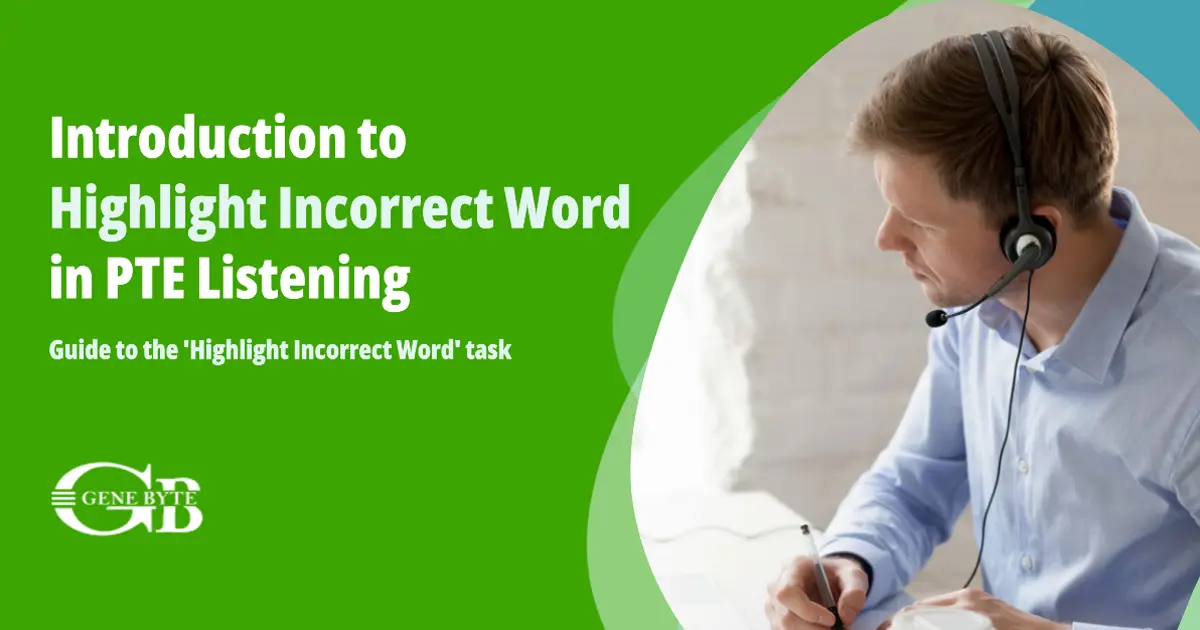Discussing PTE Listening's Highlight Incorrect Words: An Essential Guide for Teachers
Unlocking the PTE Listening's Highlight Incorrect Words Task in PTE Academic for Educators

"Mastering the 'Highlight Incorrect Words' task is not just about language proficiency; it's about sharpening real-world skills like attention to detail and cognitive agility, essential for academic and professional success."
Imagine a classroom where every student excels in PTE Academic tasks, especially the Highlight Incorrect Words in the Listening Section. Understanding and teaching this task can set your coaching methodology apart. This task is not just a test of listening skills; it combines listening with critical reading, requiring keen attention and precise identification skills.
Key Takeaways:
- Task Requirements: Students listen to an audio recording and identify words in the transcript that do not match what is said.
- Skills Assessed: Evaluates listening, reading, concentration, and cognitive agility.
- Effective Strategies: Understanding the task helps educators develop teaching methods tailored to its requirements.
- Empowering Educators: By comprehending this task, teachers can better prepare their students, enhancing their listening and reading skills, which are crucial for success in the PTE Academic and real-world English usage.
By mastering the Highlight Incorrect Words task, educators can significantly improve their students' performance. Genebyte provides the insights needed to excel in this specific segment and the entire PTE Academic exam.

Introduction to the 'Highlight Incorrect Words' Task
Overview of PTE Academic's Structure
PTE Academic, a globally recognized English proficiency test, is structured to evaluate a candidate's ability in four key language skills: speaking, writing, reading, and listening. Unlike conventional exams, PTE Academic is known for its integrated approach to language assessment, where tasks often test multiple skills simultaneously. This holistic framework is designed to reflect real-world language use, making it an essential tool for educational institutions and professionals alike.
Significance of the 'Highlight Incorrect Words' Task in the Test
The 'Highlight Incorrect Words' task follows Select Missing Word as part of the listening assessment. It has a unique blend of testing listening and reading skills. This task is not just about identifying discrepancies in a transcript. It's an authentic assessment of a student's ability to process spoken language in real-time and cross-reference it with written text. This task mirrors real-life scenarios where accurate comprehension and attention to detail are key, such as following verbal instructions while reading a manual.
The Dual Skill Assessment: Listening and Reading
The 'Highlight Incorrect Words' task is a prime example of PTE Academic's integrated skill assessment approach. Candidates are presented with an audio recording and a corresponding transcript. The challenge lies in listening to the recording, which lasts between 15 to 50 seconds, and simultaneously identifying words in the transcript that are incorrect or altered. This task rigorously tests:
- Listening Skills: It assesses a candidate's ability to understand spoken English, including various accents and speeds of speech.
- Reading Skills: It evaluates how well a candidate can read and comprehend written English, especially under time constraints.
- Cognitive Abilities: The task requires high levels of concentration, memory, and the ability to multitask effectively.
At Genebyte, we understand the critical nature of this task in PTE Academic preparation. Our SaaS solutions for coaching institutes are designed to enhance both listening and reading skills through interactive exercises and real-time feedback mechanisms. We believe that mastering tasks like 'Highlight Incorrect Words' not only prepares students for the PTE Academic but also equips them with skills beneficial in real-world English usage. Our platform offers a comprehensive suite of tools that aid educators in delivering effective training, ensuring students are well-prepared for this challenging yet crucial part of the exam.

Deep Dive into the Task's Mechanics
Task Description and Execution
- 1. The Role of the Audio Recording
In the 'Highlight Incorrect Words' task, the audio recording is the cornerstone. It typically ranges from 15 to 50 seconds, featuring a spoken passage that may encompass various topics and accents. This recording is not merely a test of auditory comprehension but a nuanced tool to gauge a candidate's proficiency in understanding and processing spoken English in a realistic context. The complexity lies in not just hearing the words but in actively listening and interpreting them in real-time.
- 2. The Transcript's Function
Concurrently, the transcript serves as a critical element in this task. Displayed alongside the audio, the transcript includes deliberately placed errors. These discrepancies challenge the candidate to effectively cross-reference what they hear with what they read. The transcript, therefore, is not just a reading exercise but a test of attention to detail and the ability to identify inconsistencies between two sources of information.
Key Characteristics of the Task
- Audio Length
The variable length of the audio (15–50 seconds) adds a layer of complexity to the task. Shorter recordings require quick adaptation, while longer ones test sustained concentration. This variability ensures that candidates are prepared for a wide range of real-world listening scenarios.
- The Interplay of Listening and Reading Skills
Like Highlight Correct Summary, this task assesses both listening and reading skills in tandem. The dual focus is on:
- Listening Skills: Understanding the content, context, and nuances of spoken English.
- Reading Skills: Comparing the audio content with the written transcript to spot discrepancies.
| Skill Type | Description | Relevance in Real-World Scenarios |
|---|---|---|
| Listening | Understanding spoken language, including accents and speech pace | Essential for effective communication in English-speaking environments |
| Reading | Accurate reading and comprehension, especially under time constraints | Crucial for tasks involving written instructions or information processing |
| Attention to Detail | Ability to notice and rectify discrepancies | Valuable in academic and professional settings where precision is key |

The Educational Perspective
Why Understanding This Task is Crucial for Educators
For educators in the field of PTE Academic preparation, a deep understanding of the 'Highlight Incorrect Words' task is crucial. This task is more than a test of language skills; it embodies the real-world application of English language proficiency. Educators who grasp the essence of this task can impart more than just test-taking strategies – they can instill in students the practical skills of active listening and critical reading. In the context of Genebyte's solutions, this understanding is pivotal in utilizing our technology to its fullest potential, enabling educators to tailor their instruction to the specific needs of each student.
The Impact on Students' Overall Language Proficiency
Mastering the 'Highlight Incorrect Words' task has a profound impact on students' overall language proficiency. It goes beyond preparing them for a section of PTE Academic; it equips them with skills that are essential in academic and professional communication. This task helps in honing attention to detail, improving concentration, and developing the ability to process information efficiently – skills that are invaluable in any language-based endeavor.
Challenges and Opportunities in Teaching this Task
Teaching the 'Highlight Incorrect Words' task presents both challenges and opportunities. One significant challenge is helping students overcome the difficulty of multitasking between listening and reading. However, this also presents an opportunity to develop innovative teaching methods. Genebyte's SaaS solutions offer interactive modules and real-time analytics, enabling educators to identify areas where students struggle and tailor their teaching methods accordingly.
| Challenge | Opportunity | Genebyte's Solution |
|---|---|---|
| Multitasking between listening and reading | Developing innovative teaching methods | Interactive modules for practice |
| Maintaining student concentration | Enhancing focus and retention skills | Real-time analytics to track progress |
| Adapting to varied accents and speeds in audio | Improving comprehension of diverse English accents | Customizable practice sessions |
| Balancing the rigor of task practice with engagement | Keeping students motivated and engaged | Engaging and diverse content offerings |
Genebyte's platform provides a comprehensive suite of tools that address these challenges, turning them into opportunities for growth and learning. By leveraging our technology, educators can transform the way they approach teaching the 'Highlight Incorrect Words' task, ultimately leading to better outcomes for their students both in the PTE Academic exam and beyond.

Insights from Genebyte's Experience
Observations on Common Student Challenges
Through our extensive experience at Genebyte, we have observed that students often face specific challenges with the 'Highlight Incorrect Words' task in PTE Academic. These include difficulties in:
- Adjusting to Different Accents: Students sometimes struggle to comprehend the variety of English accents in the audio recordings.
- Time Management: The task demands quick processing of information, which can be overwhelming for many students.
- Distraction and Loss of Concentration: The dual focus on listening and reading can lead to decreased concentration, impacting performance.
Correlation Between Task Performance and PTE Academic Success
Our analysis shows a strong correlation between a student's performance in the 'Highlight Incorrect Words' task and their overall success in PTE Academic. Mastery of this task significantly contributes to higher scores in both Listening and Reading sections, underscoring its importance in the exam.
How Educators Can Better Support Students
Educators play a crucial role in overcoming these challenges. At Genebyte, we recommend:
- Customized Training Approaches: Adapting teaching methods to individual student needs and learning styles.
- Focus on Accent Training: Incorporating varied accent training into the curriculum.
- Interactive Learning Sessions: Engaging students with interactive exercises to improve concentration and retention.
The Role of Technology in Enhancing Task Understanding
Technology, especially Genebyte's B2B SaaS solution, is instrumental in elevating the teaching and learning experience. Our platform offers:
- Real-Life Simulation Exercises: Providing students with practice materials that replicate the format and challenges of the 'Highlight Incorrect Words' task.
- Analytics-Driven Insights: Offering educators detailed analytics on student performance, enabling targeted interventions.
- Interactive and Engaging Content: Keeping students motivated and engaged through diverse and interactive learning materials.
| Student Challenge | Genebyte's Solution | Impact on Learning |
|---|---|---|
| Different Accents | Accent training modules | Improved comprehension of diverse English accents |
| Time Management | Time-bound practice tasks | Enhanced speed and efficiency in task execution |
| Concentration Issues | Engaging and interactive exercises | Better focus and task management skills |
Genebyte's SaaS platform empowers educators with the tools to effectively address these challenges, ensuring that students are not only prepared for the PTE Academic exam but also equipped with skills that transcend beyond the test. By integrating our technology into their teaching methods, educators can significantly enhance the overall language proficiency of their students, paving the way for their academic and professional success.

Actionable Tips for Educators
- Diverse Accent Training: Use audio materials with various English accents to prepare students for the PTE Academic.
- Simulate Exam Conditions: Practice with time-bound exercises to enhance time management skills.
- Use Engaging Technology: Leverage interactive tools to improve concentration and multitasking abilities.
- Focus on Listening Comprehension: Encourage active listening and interpretation of content.
- Regular Performance Reviews: Track progress with analytics to identify areas for improvement and customize teaching strategies.
The Genebyte Edge
Genebyte's B2B SaaS solution combines technology and education for advanced, efficient, and interactive PTE Academic preparation. Our platform helps educators:
- Provide comprehensive and engaging learning experiences.
- Gain insights into student performance with detailed analytics.
- Customize teaching approaches based on individual needs.
The Highlight Incorrect Words task in PTE Academic tests real-world language proficiency. Mastering this task requires strong listening and reading skills. Following this, students move to the final task, Write from Dictation. Genebyte's solutions empower educators to elevate their teaching methods and help students achieve excellence.
Ready to transform your approach to PTE Academic preparation? Explore how Genebyte can enhance your teaching and improve student outcomes. Contact us to learn more.
Frequently Asked Questions
The 'Highlight Incorrect Words' task in PTE Listening comprises an audio recording and a corresponding written transcript. Students listen to the recording and simultaneously identify words in the transcript that differ from what is said. This task assesses attention to detail in both listening and reading skills.
The 'Highlight Incorrect Words' task does not have a specific time limit for each response. However, the audio length varies between 15 to 50 seconds, and students must manage their time effectively to complete the task within the overall time allocated for the listening section.
- Practice listening to diverse English accents.
- Enhance concentration skills through regular practice.
- Develop a habit of actively comparing spoken words to written text.
- Utilize PTE preparation tools for simulated practice.
This task evaluates both listening and reading skills. It tests students' ability to understand spoken English, identify discrepancies between spoken words and written text, and concentrate over varying lengths of audio.
No, there isn't a specific time limit for each response. The task is part of the listening section, which has an overall time limit, within which students must manage all listening tasks, including 'Highlight Incorrect Words'.
The difficulty varies based on the complexity of the audio content, the speed of speech, and the accents used. The unpredictability of these factors contributes to the variability in difficulty across different PTE exams.
Key strategies include:
- Focusing on understanding the overall context of the audio.
- Paying close attention to the pronunciation of words.
- Practicing with a variety of accents and speeds to build adaptability.
Typically, each audio in the 'Highlight Incorrect Words' task features a single accent. However, students should be prepared to encounter a range of accents throughout the PTE Listening section.
The audios can feature a variety of English accents, including British, American, Australian, and non-native accents. This variety prepares students for the global nature of English language use.
Yes, there is negative marking in this task. Incorrect answers will deduct points, so it's crucial for students to answer accurately.
The frequency of new words in each exam is variable. The task aims to test comprehension and attention, not vocabulary knowledge. However, regular practice can familiarize students with common word discrepancies.
This task significantly contributes to the overall scoring in both the listening and reading sections. Excelling in this task can positively impact a student's comprehensive PTE score.
Effective practice can be achieved through:
- Regularly practicing with simulated PTE tasks.
- Focusing on improving concentration and multitasking skills.
- Using Genebyte's SaaS solutions that offer real-time practice and feedback.